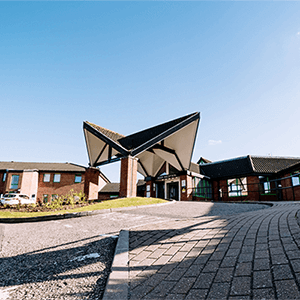
Search by region


A nephrostomy can help to drain urine from your body using a thin plastic tube called a catheter. It is performed if you have a blocked ureter as this is a serious condition.
Nephrostomy is a common interventional procedure. It is performed by our experienced interventional radiologists in our hospital’s modern and well-equipped imaging departments.
We offer convenient appointments without waiting at a local Ramsay hospital near you and will perform the procedure quickly. Our friendly and professional team will offer you support and advice on your looking after your nephrostomy tube.
Strict infection control protocols are in place in all Ramsay hospitals to keep you and our staff safe whilst visiting.
A nephrostomy is a safe and effective procedure to drain urine from your kidney using a catheter tube.
Urine is produced in your kidneys and then passes through ureter tubes to your bladder.
Sometimes, kidney stones, clots or cancers can block one or both of your ureters and prevent urine from leaving your body.
By inserting a thin plastic catheter tube into your kidney your urine can be drained away. This is a temporary fix whilst your doctor finds out the cause of your blocked ureter and treats it.
Your consultant will explain your nephrostomy procedure and how you should prepare for it.
You should let your consultant know about any medications or supplements that you are taking. They might instruct you to temporarily stop taking them prior to your procedure. This may be the case if you take antiplatelet medicines or blood-thinning medicines. Other medications such as those for diabetes or insulin may need to be changed around the time of your procedure. You should follow your consultant’s advice.
Your healthcare team will also advise you on your food and drink intake before the procedure. There may be restrictions on these.
Nephrology is usually performed relatively urgently within a few days to prevent permanent kidney damage.
You will be given a local anaesthetic injection into your kidney area where the needle will be inserted.
A radiologist who is a doctor who specialises in X-rays and scans usually performs a nephrostomy on a special X-ray table. They use ultrasound and imaging guidance to insert the catheter into your kidney using a needle and thin flexible guide wires.
A fine needle is inserted into your kidney and once they are certain the needle is in the correct position, a guidewire is passed through the needle and a plastic catheter replaces the needle. The catheter is fixed to the skin of your back and attached to a plastic drainage bag to collect your urine.
A nephrostomy can take 30 minutes to an hour to perform, depending on the difficulty of the surgery.
A nephrostomy will reduce your risk of kidney damage. It preserves your kidney function and allows it to function normally. Without a nephrotomy, stagnant urine may become infected with bacteria and this could spill into your bloodstream and cause sepsis.
This temporary solution gives your consultant time to find out why your ureter is blocked and to treat the problem.
The cost of a nephrostomy will depend on your Ramsay hospital of choice.
You will receive a formal quotation price for your nephrostomy procedure following a consultation with one of our expert urologists. This formal quote for your surgery will be valid for 60 days.
Ramsay is recognised by all major medical insurers. Nephrostomy procedures are covered by most medical insurance policies. We advise you to obtain written authorisation from your insurance provider before your procedure.
We have a number of finance options if you are paying for your nephrostomy yourself. These include interest-free finance with no deposit and monthly instalments at 0% interest, all-inclusive Total Care where you make a one-off payment at a pre-agreed price or pay as you go that offers a flexible funding option.
You may be able to go home the same day as your procedure.
The catheter will need to stay in place until the cause of the blocked ureter has been treated.
If you go home while the catheter is still in place, your healthcare team will show you how to look after it and change the bag. You must take care of your drainage bag and empty it frequently so that the nephrostomy does not get pulled out.
You should keep the skin around the nephrostomy tube clean to prevent infection. You may have a sterile dressing where the tube leaves your skin that will need changing regularly.
Your doctor will decide how long your drainage tube needs to stay in place.


At Pinehill Hospital, our dedicated private General Practitioners (GPs) are here to offer you guidance and treatment for chronic migraines.
Clifton Park Hospital, in York, Part of Ramsay Health Care UK, has been shortlisted for the 2026 HSJ partnership award.
Ramsay Health Care UK are celebrating after being named as a Gold National Joint Registry (NJR) Quality Data Provider for the second year running, after successfully completing a national data quality audit programme for 25 hospitals offering orthopaedic procedures.
The information, including but not limited to, text, graphics, images and other material, contained on this website is for educational purposes only and not intended to be a substitute for medical advice, diagnosis or treatment. Always seek the advice of your physician or other qualified health care provider with any questions you may have regarding a medical condition or treatment.
No warranty or guarantee is made that the information contained on this website is complete or accurate in every respect. The testimonials, statements, and opinions presented on our website are applicable to the individuals depicted. Results will vary and may not be representative of the experience of others. Prior patient results are only provided as examples of what may be achievable. Individual results will vary and no guarantee is stated or implied by any photo use or any statement on this website.
Ramsay is a trusted provider of plastic or reconstructive surgery treatments as a part of our wrap-around holistic patient care. Our personal, friendly and professional team are here to support you throughout to ensure the best possible care. All procedures we perform are clinically justified.
*Acceptance is subject to status. Terms and conditions apply. Ramsay Health Care UK Operations Limited is authorised and regulated by the Financial Conduct authority under FRN 702886. Ramsay Healthcare UK Operations is acting as a credit broker to Chrysalis Finance Limited.
Ramsay Health Care UK is not currently recruiting for any roles based outside of England. If you are interested in applying for a role with Ramsay Health Care UK, please note that all available positions are advertised exclusively on our official website: https://www.ramsayhealth.co.uk/careers. Be cautious of individuals or organisations that approach you directly for remotely-based roles. Always verify the authenticity of the job offer and be careful with whom you share your personal information. For more information and advice on employment fraud, please visit: https://www.ramsayhealth.co.uk/careers/recruitment-fraud